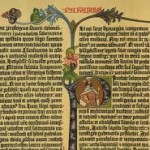The question of where to begin reading more about rare books is an enigmatic query faced by many individuals who are interested in familiarizing themselves with the fascinating rewards that are inevitably attained in the world of rare, old and vintage books. We believe that a short introduction with a 101 post on rare books will serve as a helpful guideline to anyone that is in the exploration stage of this wonderful journey.
What is a rare book: In order to clearly understand the field of rare books, we must first consider what the organic and “stripped down” definition of rare books actually is. Taking a brief interval to understand this commonly mistaken definition will set the needed boundaries in place, and will grant the rare book enthusiast a lucid and coherent understanding of the topic. It is imperative to first understand that in the varied and diverse world of rare books, different groups or individuals are prone to use different terms for the rare book. The terms most commonly used are: scarce, old, antiquarian and vintage book to name a few. What perhaps may seem a bit confusing is that these popular terms are defined in unique ways in the eclectic minds of all who are a part of the rare book world. For example, the term rare book from the collector’s point of view, is a book that is not easily found, and is thus a book that is scarce and in high demand. From the seller’s perspective however, a rare book is simply a book that has a certain value and is desired for ownership by many people. In a more general sense, a rare book is a scarce resource that has a certain value and a price which increases as the demand for it also increases.
What makes the book rare: In our article, ‘’Rare books: what makes them rare?’’, we have given the 9 attributes that deem a book as rare as well as short explanations of the effect of each of these attributes to the value of the books considered. We try to analyze the causes and effects of variations in each of these attributes.
Is age a major factor? Age is one of the 9 parameters that place a book in the coveted rare category. It is an attribute which cannot be ignored in the appraisal of a potentially rare book’s worth. Pausing to reflect on the progress of book printing throughout the centuries allows us the realization that countless important books which were printed between the beginning of printed books in 1450, and the birth of printing mechanisms in the 19th century, have become quite rare and valuable. This progression of worth is one illustration of the desirable effects in which age plays a role. Throughout the centuries it is inevitable for tragic circumstances to be inflicted on these books such as many of them becoming destroyed or lost over time, thus causing the survived copies to be extremely scarce.
Handling and care: Rare books certainly require special handling and care. It is important to keep them stored carefully on special racks and under certain degrees of temperature and humidity. Additionally, great care should be used when they are handled, examined, moved or read. This is not a precaution to be taken lightly. Libraries and antiquarian bookstores have invested in special rooms with security precautions which allow those interested to take and observe the rare books under a watchful eye. Please look for more details on this in a future article.
The role of first edition: First edition books are extremely valuable, as well as limited edition books. The first edition factor is a part of the scarcity attribute in that first editions are printed conservatively, as the success of a book is an unknown experiment. Due to this unclear future, there are fewer first edition books of a certain publication printed, enabling the few that are printed to be quite scarce especially after the work proves to be popular.
The most well known rare book: As it is with any tangible asset, there is the most important rare book just as there is the tallest building or the rarest diamond. A number of field experts agree, that the most well known rare book is the Gutenberg Bible. Why is this? First off, it was printed by the printer and publisher Johannes Gutenberg, who is now considered to be the father of modern printing. Out of only 180 copies of the Gutenberg Bible printed, only 50 survived, and of those 50, only 20 are complete and in good condition. Thus, the Gutenberg Bible is considered as the rarest of the rare. If one of these 20 surviving copies was found for purchase, it would be worth more than 35 million USD. In fact, single pages alone of this Bible are sold for 25,000 USD each!
We hope that you find this brief introduction to the world of rare books to be helpful and enlightening. For those who have heard it all before we hope that we did offer something new and different. Most of all we hope that we have planted some interest and sparked curiosity just a little bit to explore the world of rare books deeper, or as the book collectors playfully say, induced the biting of the book bug! Our blog is aiming to do just that: raise interest and curiosity about rare books, and the innumerable benefits which the world of rare books has to offer to the inquiring and appreciative mind.


{ 0 comments… add one now }